Bassae › Bastet › Prince Shotoku: Founder of Japanese Buddhism and the Japanese Nation » Origins and History
Articles and Definitions › Contents
- Bassae › Who Was
- Bastet › Who Was
- Prince Shotoku: Founder of Japanese Buddhism and the Japanese Nation › Origins
Ancient civilizations › Historical places, and their characters
Bassae › Who Was
Definition and Origins

Bassae (Bassai), located in south-west Arcadia on the slopes of Mt. Kotilion, was an important temple site in the Archaic and Classical periods. Its large 5th-century BCE temple of Apollo, now covered with a permanent roof, is one of the best-preserved temples in Greece and displays important innovations in Greek architecture.
HISTORICAL OVERVIEW
The name Bassae derives from the many small ravines ( bassae or bissae ) amongst the rocks of Mt. Kotilion. The sanctuary, which developed its own small settlement, was connected to the nearest town, Phigaleia, via a sacred way. The settlers of Bassae were also responsible for another sanctuary higher up the mountain dedicated to Artemis and Aphrodite.
The first votive offerings at the sanctuary site of Bassae date to the last quarter of the 8th century BCE. Four temples were built to Apollo, starting in the 7th century BCE and ending in the 5th century BCE, each replacing and larger than its predecessor. The sanctuary was not only dedicated to Apollo, though, as one inscribed vessel reports a cult to Aphaea, the fertility and agricultural goddess, and there was a precinct dedicated to Pan, the pastoral god. Next to the famous temple of Apollo there is a sacred building, or sekos, with two chambers and evidence of a metallurgy workshop. Finds at the site include votive offerings of fine pottery from Corinth and Laconia, ceramic figures, jewellery, a tortoise-shell lyre, and many small bronze figurines. Bassae's importance began to fade from the 4th century BCE with the founding of the Arcadian League and Megalopolis by Thebes in 371-370 BCE, which meant the site received fewer and fewer dedicatory offerings and was eventually abandoned.
THE TEMPLE OF BASSAE WAS DEDICATED TO APOLLO EPICURIUS (OR 'APOLLO THE HELPER') WHICH MAY REFER TO MILITARY AID AS MANY LOCALS FOUGHT AS MERCENARIES.
THE TEMPLE OF APOLLO
The large temple of Bassae was dedicated to Apollo Epicurius (or 'Apollo the Helper') which may refer, not to any medicinal connotation, but to the fact that many Arcadians fought as mercenaries for Messenia against Sparta. In Greek, an epikouroswas both an ally and mercenary. Certainly, the site received an unusual amount of dedicatory weapons and armour, typically made in miniature. Another epithet of Apollo, the local 'Bassitas', is found on a bronze tablet inscribed with details of a manumission.
The temple was completed, after an interruption caused by the Peloponnesian War, in the latter decades of the 5th century BCE. According to the 2nd-century CE Greek travel writer Pausanias, it was designed by Ictinus, who was also the architect of the Parthenon. There is no supporting evidence for this claim, and elements of the architecture of the temple do display a local influence. It is a unique combination of all three Classical Greek architectural orders with, for example, a Doric columned exterior, an interior Ionic decorative frieze, and a single Corinthian column and capital inside.

Plan, Temple of Apollo, Bassae
The temple was built on the site of an earlier, smaller version (600-570 BCE) and is, likewise, aligned to the north. Most Greek temples were constructed on an east-west axis. Consequently, there is an opening in the east wall to permit morning sunlight to enter and light the interior. The exterior had 6 columns on the facades and 15 on the long sides. Instead of a sculptural frieze, the exterior decoration is provided by alternating plain metopes and triglyphs.
Inside, the side walls of the cella have tall engaged Ionic columns (five on each side) while the adytum room (which housed the cult statue of the god) is separated from the cella by a single Corinthian column, centrally placed. The temple is the first known building to use a Corinthian capital. Another indicator of a master architect at work is the interior ceiling, which is composed of marble coffers (sunken square panels) with purposely cambered (curved) backs to increase their load-bearing strength. Unusually, there were no wooden elements to the interior ceiling, and all beams and rafters were made using stone.The roof of the temple was made with marble slabs and shows signs of later Hellenistic period repairs using terracotta.

Greek & Amazons, Frieze from Bassae
While the exterior of the temple is rather austere, shorn as it is of any decoration, the interior has figure sculpture. This is rendered in marble while the rest of the temple is of local limestone. The slabs of the frieze, now in the British Museum in London, depict battles involving centaurs fighting Lapiths and Greeks battling Amazons. Originally there were 23 slabs creating 31 metres of frieze. The metopes of the pronaos (the interior entrance space) also carried sculpture. These depicted two mythological scenes: the Dioskouroi ( Castor and Pollux ) raping the daughters of Leucippus, a king of Messenia, and Apollo returning from Mt. Olympus.
Bastet › Who Was
Definition and Origins
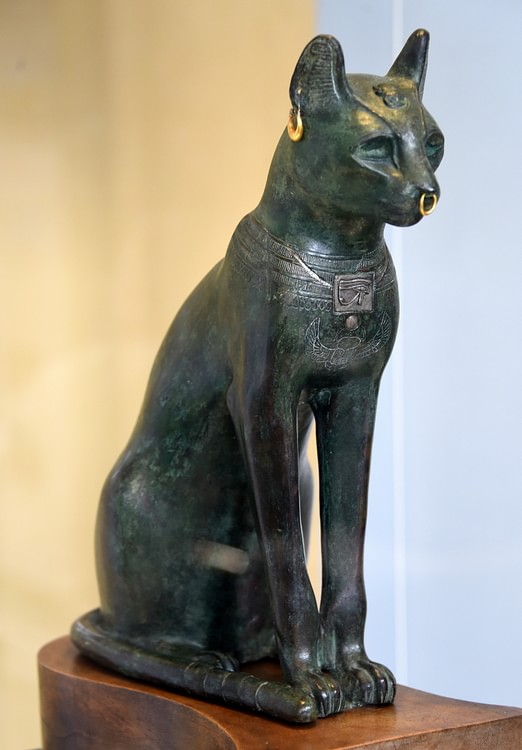
Bastet is the Egyptian goddess of the home, domesticity, women's secrets, cats, fertility, and childbirth. She protected the home from evil spirits and disease, especially diseases associated with women and children. As with many Egyptian deities, she also played a role in the afterlife as a guide and helper to the dead although this was not one of her primary duties. She was the daughter of the sun god Ra and is associated with the concept of the Eye of Ra (the all-seeing eye) and the Distant Goddess (a female deity who leaves Ra and returns to bring transfromation).
MEANING OF BASTET'S NAME
Her name was originally B'sst which became Ubaste, then Bast, then Bastet; the meaning of this name is not known or, at least, not universally agreed upon. Geraldine Pinch claims that "her name probably means She of the Ointment Jar" as she was associated with protection and protective ointments (115). The Greeks associated her closely with their goddess Artemisand believed that, as Artemis had a twin brother ( Apollo ) so should Bast. They associated Apollo with Horus, the son of Isis(Heru-sa-Aset) and so called the goddess known as Bast ba'Aset (Soul of Isis) which would be the literal translation of her name with the addition of the second 'T' to denote the feminine (Aset being among the Egyptian names for Isis).
Bastet, however, was also sometimes linked with the god of perfume and sweet smells, Nefertum, who was thought to be her son and this further links the meaning of her name to the ointment jar. The most obvious understanding would be that, originally, the name meant something like She of the Ointment Jar (Ubaste) and the Greeks changed the meaning to Soul of Isis as they associated her with the most popular goddess in Egypt. Even so, scholars have come to no agreement on the meaning of her name.

Bastets & Sekhmets
ASSOCIATIONS
Bastet was extremely popular throughout Egypt with both men and women from the 2nd Dynasty (c. 2890 - c. 2670 BCE) onward with her cult centered at the city of Bubastis from at least the 5th century BCE. She was first represented as a woman with the head of a lioness and closely associated with the goddess Sekhmet but, as that deity's iconography depicted her as increasingly aggressive, Bastet's images softened over time to present more of a daily companion and helper than her earlier forms as savage avenger. Scholar Geraldine Pinch writes:
From the Pyramid Texts onward, Bastet has a double aspect of nurturing mother and terrifying avenger. It is the demonic aspect that mainly features in the Coffin Texts and the Book of the Dead and in medical spells. The "slaughterers of Bastet" were said to inflict plague and other disasters on humanity. One spell advises pretending to be the 'son of Bastet' in order to avoid catching the plague (115).
BASTET IS SOMETIMES RENDERED IN ART WITH A LITTER OF KITTENS AT HER FEET BUT HER MOST POPULAR DEPICTION IS OF A SITTING CAT GAZING AHEAD.
Although she was greatly venerated, she was equally feared as two of her titles demonstrate: The Lady of Dread and The Lady of Slaughter. She is associated with both Mau, the divine cat who is an aspect of Ra, and with Mafdet, goddess of justice and the first feline deity in Egyptian history. Both Bastet and Sekhment took their early forms as feline defenders of the innocent, avengers of the wronged, from Mafdet. This association was carried on in depictions of Bastet's son Maahes, protector of the innocent, who is shown as a lion-headed man carrying a long knife or as a lion.
In Bastet's association with Mau, she is sometimes seen destroying the enemy of Ra, Apophis, by slicing off his head with a knife in her paw; an image Mau is best known by. In time, as Bastet became more of a familial companion, she lost all trace of her lionine form, and was regularly depicted as a house cat or a woman with the head of a cat often holding a sistrum. She is sometimes rendered in art with a litter of kittens at her feet but her most popular depiction is of a sitting cat gazing ahead.
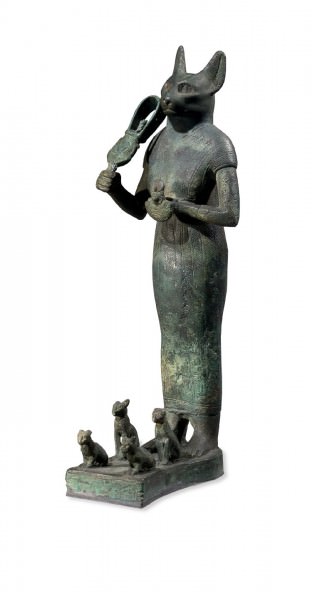
Bastet
ROLE IN RELIGION & ICONOGRAPHY
Bastet appears early in the 3rd millenium BCE in her form as an avenging lioness in Lower Egypt. By the time of the Pyramid Texts (c. 2400-2300 BCE) she was associated with the king of Egypt as his nursemaid in youth and protector as he grew. In the later Coffin Texts (c. 2134-2040 BCE) she retains this role but is also seen as a protector of the dead. The scholar Richard H. Wilkinson comments on this:
In her earliest known form, as depicted on stone vessels of the 2nd dynasty, Bastet was represented as a woman with the maneless head of a lioness. The iconography of the goddess changed, however, perhaps as her nature began to be viewed as milder than that of other lioness deities (178).
Her cult center at Bubastis in Lower Egypt became one of the richest and most luxuriant cities in Egypt as people from all over the country traveled there to pay their respects to the goddess and have the bodies of their dead cats interred in the city. Her iconography borrowed from the earlier goddess Mafdet and also from Hathor, a goddess associated with Sekhmet who was also closely linked to Bastet. The appearance of the sistrum in Bastet's hand in some statues is a clear link to Hathor who is traditionally seen carrying the instrument. Hathor is another goddess who underwent a dramatic change from bloodthirsty destroyer to gentle friend of humanity as she was originally the lioness deity Sekhmet whom Ra sent to earth to destroy humans for their sins. In Bastet's case, although she became more mild, she was no less dangerous to those who broke the law or abused others.
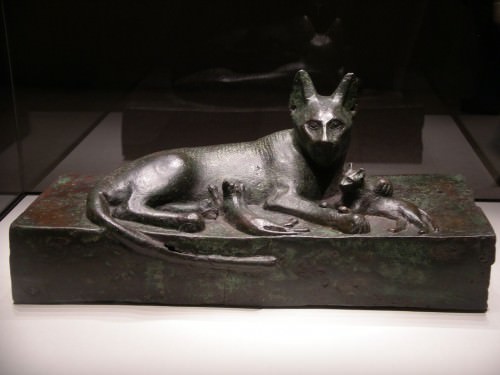
Egyptian Cat
THE TALE OF SETNA & TABOUBU
The Tale of Setna and Taboubu (part of the work known as First Setna or Setna I) is the middle section of a work of Egyptian literature composed in the Roman Period of Egypt's history and currently held by the Cairo Museum in Egypt. The main character of the Setna tales is Prince Setna Khaemwas who is based on the actual prince and High Priest of Ptah Khaemweset (c. 1281 - c.1225 BCE) the son of Ramesses II. Khaemweset, known as the "First Egyptologist", was famous for his restoration and preservation efforts of ancient Egyptian monuments and, by the time of the Ptolemaic Period, was greatly revered as a sage and magician. Although the story may be interpreted in many different ways, Geraldine Pinch argues that this section of the tale can most clearly be understood as an illustration of how Bastet punishes transgressors.
In this story young Prince Setna steals a book from a tomb, even after the inhabitants of the tomb beg him not to. Shortly afterwards he is in Memphis, near the Temple of Ptah, when he sees a beautiful woman accompanied by her servants and lusts after her. He asks about her and learns her name is Taboubu, daughter of a priest of Bastet. He has never seen any woman more beautiful in his life and sends her a note asking her to come to his bed for ten gold pieces but she returns a counter-offer telling him to meet her at the Temple of Bastet in Saqqara where she lives and he will then have all he desires.
Setna travels to her villa where he is eager to get to the business at hand but Taboubu has some stipulations. First, she tells him, he must sign over all his property and possessions to her. He is so consumed with lust that he agrees to this and moves to embrace her. She holds him off, however, and tells him that his children must be sent for and must also sign the documents agreeing to this so that there will be no problems with the legal transference. Setna agrees to this also and sends for his children. While they are signing the papers Taboubu disappears into another room and returns wearing a linen dress so sheer that he can see "every part of her body through it" and his desire for her grows almost uncontrollable. With the documents signed he again moves toward her but, no, she has a third demand: his children must be killed so that they will not try to renege on the agreement and embroil her in a long, drawn-out court battle. Setna instantly agrees to this; his children are murdered and their bodies thrown into the street. Setna then pulls off his clothes, takes Taboubu, and leads her quickly to the bedroom. As he is embracing her she suddenly screams and vanishes - as does the room and villa around them - and Setna is standing naked in the street with his penis thrust into a clay pot.
The pharaoh comes by at this time and Prince Setna is completely humiliated. Pharaoh informs him that his children still live and that everything he has experienced has been an illusion. Setna then understands he has been punished for his transgression in the tomb and quickly returns the book. He further makes restitution to the inhabitants of the tomb by traveling to another city and retrieving mummies buried there who were part of the tomb inhabitant's family so they can all be reunited in one place.
Although scholars disagree on who Taboubu represents, her close association with Bastet as the daughter of one of the goddesses' priests makes this deity a very likely candidate. The predatory nature of Taboubu, once she has Setna where she wants him, is reminiscent of the cat toying with the mouse. Geraldine Pinch concludes that Taboubu is a "manifestation of Bastet herself, playing her traditional role of punisher of humans who have offended the gods" (117). In this story Bastet takes on the form of a beautiful woman to punish a wrong-doer who had violated a tomb but the story would also have been cautionary to men who viewed women only as sexual objects in that they could never know whether they were actually in the presence of a goddess and what might happen should they offend her.
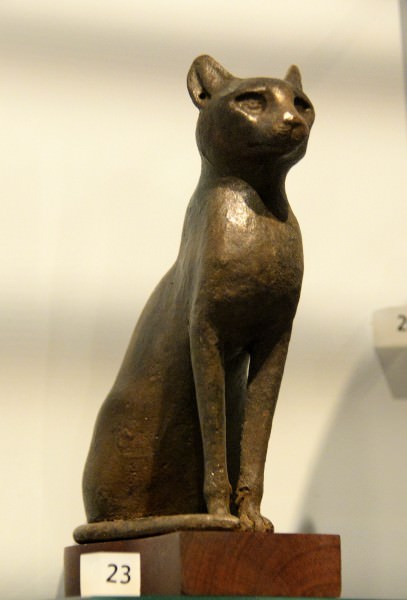
Bronze Cat from Egypt
WORSHIP OF BASTET
The goddess was worshipped primarily at Bubastis but held a tutelary position at Saqqara and elsewhere. Wilkinson writes:
The goddess's popularity grew over time and in the Late Period and Graeco-Roman times she enjoyed great status. The main cult centre of this deity was the city of Bubastis - Tell Basta - in the eastern Delta, and although only the outlines of the temple of Bastet now remain, Herodotus visited the site in the 5th century BC and praised it for its magnificence. The festival of Bastet was also described by Herodotus who claimed it was the most elaborate of all the religious festivals of Egypt with large crowds participating in unrrestrained dancing, drinking, and revelry (178).
Herodotus is the primary source for information on the cult of Bastet and, unfortunately, does not go into great detail on the particulars of her worship. It seems both men and women served as her clergy and, as with the other Egyptian deities, her temple at Bubastis was the focal point of the city providing services ranging from medical attention to counseling to food distribution. Herodotus describes this temple:
Save for the entrance, it stands on an island; two separate channels approach it from the Nile, and after coming up to the entry of the temple, they run round it on opposite sides; each of them a hundred feet wide, and overshadowed by trees. The temple is in the midst of the city, the whole circuit of which commands a view down into it; for the city's level has been raised, but that of the temple has been left as it was from the first, so that it can be seen into from without. A stone wall, carven with figures, runs round it; within is a grove of very tall trees growing round a great shrine, wherein is the image of the goddess; the temple is a square, each side measuring a furlong. A road, paved with stone, of about three furlongs' length leads to the entrance, running eastward through the market place, towards the temple of Hermes ; this road is about 400 feet wide, and bordered by trees reaching to heaven. (Histories, II.138).
The people of Egypt came annually to the great festival of Bastet at Bubastis which was one of the most lavish and popular events of the year. Geraldine Pinch, citing Herodotus, claims, "women were freed from all constraints during the annual festival at Bubastis. They celebrated the festival of the goddess by drinking, dancing, making music, and displaying their genitals" (116). This "raising of the skirts" by the women, described by Herodotus, had as much to do with freedom from social constraints as it did with the fertility associated with the goddess. As with many of the other festivals throughout Egypt, Bastet's celebration was a time to cast aside inhibitions much in the way modern revelers do in Europe during Carnivale or in the United States at Mardi Gras. Herodotus presents a vivid picture of the people traveling to Bubastis for the festival:
When the people are on their way to Bubastis, they go by river, a great number in every boat, men and women together. Some of the women make a noise with rattles, others play flutes all the way, while the rest of the women, and the men, sing and clap their hands. As they travel by river to Bubastis, whenever they come near any other town they bring their boat near the bank; then some of the women do as I have said, while some shout mockery of the women of the town; others dance, and others stand up and lift their skirts. They do this whenever they come alongside any riverside town. But when they have reached Bubastis, they make a festival with great sacrifices, and more wine is drunk at this feast than in the whole year besides. It is customary for men and women (but not children) to assemble there to the number of seven hundred thousand, as the people of the place say ( Histories, Book II.60).
Although Herodotus claims that this festival outstripped all others in magnificence and excess, in reality there were many festivals celebrating many gods which could claim the same. The popularity of this goddess, however, made her celebration of particular significance. In the passage above, Herodotus makes note of how the women in the boats mocked those on shore and this would have been done to encourage them to leave off their daily tasks and join the celebration of the great goddess.Bastet, in fact, was second only to Isis in popularity and, once she traveled through Greece to Rome, was equally popular among the Romans and the subjects of their later empire.
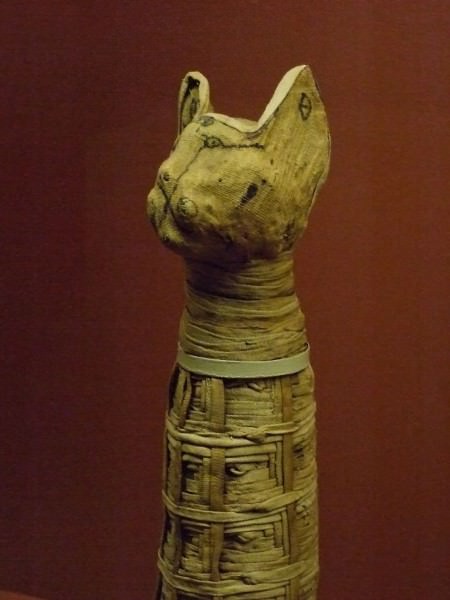
Cat Mummy
BASTET'S ENDURING POPULARITY
The popularity of Bastet grew from her role as protector of women and the household. As noted, she was as popular among men as women in that every man had a mother, sister, girlfriend, wife, or daughter who benefited from the care Bastet provided. Further, women in Egypt were held in high regard and had almost equal rights which almost guaranteed a goddess who protected women and presided over women's secrets an especially high standing. Cats were also greatly prized in Egypt as they kept homes free of vermin (and so controlled diseases), protected the crops from unwanted animals, and provided their owners with fairly maintenance-free company. One of the most important aspects of Bastet's festival was the delivery of mummified cats to her temple. When the temple was excavated in 1887 and 1889 CE over 300,000 mummified cats were found. Wilkinson, commenting on her universal popularity, writes:
Amulets of cats and litters of kittens were popular New Year gifts, and the name of Bastet was often inscribed on small ceremonial `New Year flasks', probably to evoke the goddess as a bestower of fertility and because Bastet, like other lioness goddesses, was viewed as a protective deity able to counter the darker forces associated with the `Demon Days' at the end of the Egyptian year (178).
Bastet was so popular that, in 525 BCE, when Cambyses II of Persia invaded Egypt, he made use of the goddess to force the Egyptian's surrender. Knowing of their great love for animals, and cats especially, he had his soldiers paint the image of Bastet on their shields and then arranged all the animals that could be found and drove them before the army toward the pivotal city of Pelusium. The Egyptians refused to fight for fear of harming the animals and offending Bastet and so surrendered. The historian Polyaenus (2nd century CE) writes how, after his victory, Cambyses II hurled cats from a bag into the Egyptian's faces in scorn that they would surrender their city for animals. The Egyptians were undeterred in their veneration of the cat and their worship of Bastet, however. Her status as one of the most popular and potent deities continued throughout the remainder of Egypt's history and on into the era of the Roman Empire until, like the other gods, she was eclipsed by the rise of Christianity.
Prince Shotoku: Founder of Japanese Buddhism and the Japanese Nation › Origins
Ancient Civilizations
In Japan in 573 CE Anahobe, the wife of the Emperor's son, had a dream of a priest in golden robes who asked her if he could lodge in her womb as he was about to be born as a world-saving Bodhisattva. The child was born painlessly and unexpectedly in the imperial stables and was named Shotoku ( sho meaning sacred, and toku meaning virtue). At the age of 2, he naturally placed his hands together in gassho (reverence), faced the East, and recited the words, Namu Butsu (praise be to Buddha ). Buddhism had hardly been heard of in Japan at that time! Prince Shotoku was to rule Japan between 594-622 CE as Regent and to unite his nation of warring clans in the dual roles of the first Buddhist statesman in the world and the lay founder of Japanese Buddhism.

Prince Shotoku as a Youth
Prince Shotoku had several titles:
- Prince of the Stable Door ( Umayodo no Miko ) due to the unusual circumstances of his birth.
- Prince of Eight Ears ( Yatsumimi no Miko ) because of his special intelligence and his ability to listen to eight people at one time and understand each of them.
- Prince of the Upper Palace ( Kamitsumiya no Miko or Jogu Taishi ) because his father, Emperor Yōmei, loved and respected his talented son so much that he created a special part of the palace for him to live in.
ACHIEVEMENTS
The civic contributions made by Jogu Taishi (the title most people in Japan give him) were impressive and are still in place.Among them, he created the 'cap system' for government officials which rooted out nepotism with the recognition of merit. He imported Chinese culture along with the lunar calendar, art and scholarship and he resumed the existing practice of dispatching of envoys to import all manner of cultural and religious knowledge to Japan which had been terminated. He initiated irrigation projects to improve agriculture and implemented extensive welfare measures. He created highway systems and he wrote the first chronicle of Japanese history.
BUDDHISM IN JAPAN
How he came to be devoted to this new faith which suddenly appeared in the islands of Japan is something of a mystery as mentioned above. However, though a Buddhist scholar and the first patriarch of Japanese Buddhism, he remained a lay practitioner throughout his life. It is thought that Buddhism first became known in Japan when the ruler of a province of Koreacalled Baekje visited Japan and presented a beautiful gold -plated image of Buddha Shakyamuni and sutra scrolls to Emperor Kimmei (531-571), Shotoku's grandfather, who was impressed. However, his enthusiasm to adopt Buddhism threw the principal families of Japan into confusion.
Japan had been culturally isolated and conservative until then and showed no sign that the indigenous religion, Shinto, the 'Way of the Gods,' was inadequate. Shinto develops a deep appreciation of natural beauty and spirituality but there is no ethical element, unlike Buddhism. Also, at the time there was no formal written language in Japan so the enthusiastic adoption of Chinese pictographs happened simultaneously with the influx of Buddhist sutras in Chinese translation.
However, Shotoku, now Prince Regent to his Aunt Suiko who succeeded her husband in 593 CE, was to convince the country that Buddhism was exactly what was needed. In fact, at the age of 14, he fought in a brief civil war between the progressive Soga family who favoured Buddhism and the conservative Monobes family. It was a Holy War fought over the enshrinement of Holy relics in a pagoda ( stupa ) which Shotoku insisted was essential as the origin of Buddhism was so far away from Japan in India.

Prince Shotoku
Surprisingly, Buddhism replaced Shinto as the national religion of Japan within 50 years exactly due to its values of tolerance, rationality and philosophical depth, none of which featured in the Shinto faith. The only remnant of Shinto which was retained was the link between members of the Imperial family and the Japanese goddess of the Sun and the Universe, Amaterasu, who are still considered to be her direct descendants.
Perhaps the story which best exemplifies Shotoku's devout Buddhist faith as an adult is when his father became seriously ill.The Prince sat by his father's bedside day and night meditating on his recovery and as a result, he did recover and became a devoted Buddhist himself.
TEMPLES & TEACHINGS
The Prince initiated the first two Buddhist temples to be built in Japan. Shitenno-ji (530 CE), the temple of the Four Heavenly Kings, of the North, South, East and West, was erected because whilst defending his family in battle, he prayed intently to the 4 Buddhist Kings and victory was achieved. Later Horyu-ji was built in Nara to contain many treasured artworks and artefacts, and he went on to build five more. But these temples were not merely places of worship. Shitenno-ji, built at the seaport, was a religious sanctuary providing training in music and the arts, a dispensary for medical herbs, an asylum for the abandoned and a hospital and sanatorium. Monks took many roles in society, as educators, physicians, and even engineers. Temples in Japan today are often cultural and welfare centres.
Prince Shotoku also gave public lectures on various aspects of Buddhism. He authored eight volumes of commentaries on sutras. The Sangyo- gisho (3 Sutras) was popular among lay Buddhists. It focused on the Lotus Sutra which conveyed Buddha Nature and universal enlightenment, the Vimalakirti Sutra which expounded lay Buddhism and national rulers as Bodhisattvas, and the Srimaladevi Sutra which extolled the virtues of a Buddhist Queen to honour his devout aunt, Princess Suiko.
SHOTOKU'S CONSTITUTION
'HARMONY IS THE MOST PRECIOUS ASSET. WE ALL ALTERNATE BETWEEN WISDOM & MADNESS. IT IS A CLOSED CIRCLE.' SHOTOKU SEVENTEEN-ARTICLE CONSTITUTION
The 5 bonds of Confucius figure in each article: ruler to ruled, father to son, elder to younger siblings, elder friend to younger friend, and husband to wife. Shotoku declared, ''Harmony is the most precious asset. We all alternate between wisdom and madness. It is a closed circle.' According to the Nihon Shoki, a definitive history of ancient Japan written in circa 720 CE, Prince Shotoku created a seventeen-article 'constitution' (Jpn. Jushichojo Kenpo ) which was implemented as a political tool to unite the warring clans. This was not a modern constitution designed for the governing of state and subjects, but a set of spiritual aspirations inspired equally by Buddhism and Confucianism. It focused on the morals and virtues that should be the aspiration of every subject in the realm and led to him receiving the title 'Dharma Monarch' (Skt; Dharmaraja )
The following articles are evidence that this is truly a Buddhist constitution: Article 2: Reverence to the 3 Treasures of Buddhism – Shotoku firmly believed that all beings could benefit from their truth. Article 6: the difference between merit and demerit, reward and punishment – this demonstrates the laws of karma so central to Buddhism. Article 10: self-control and mind-control – the harmony between nature and society, also a strong goal of the Buddhist way of life. They are as follows:
1. Harmony should be valued and quarrels should be avoided.2. The three treasures, which are Buddha, the (Buddhist) Law and the (Buddhist) Priesthood; should be given sincere reverence, for they are the final refuge of all living things.3. Do not fail to obey the commands of your Sovereign. He is like Heaven, which is above the Earth, and the vassal is like the Earth, which bears up Heaven.4. The Ministers and officials of the state should make proper behavior their first principle, for if the superiors do not behave properly, the inferiors are disorderly.5. Deal impartially with the legal complaints which are submitted to you.6. Punish the evil and reward the good.7. Every man has his own work. Do not let the spheres of duty be confused.8. Ministers and officials should attend the Court early in the morning and retire late, for the whole day is hardly enough for the accomplishment of state business.9. Good faith is the foundation of right.10. Let us control ourselves and not be resentful when others disagree with us, for all men have hearts and each heart has its own leanings.11. Know the difference between merit and demerit.12. Do not let the local nobility levy taxes on the people.13. All people entrusted with office should attend equally to their duties.14. Do not be envious! For if we envy others, then they, in turn, will envy us.15. To subordinate private interests to the public good — that is the path of a vassal.16. Employ the people in forced labor at seasonable times.17. Decisions on important matters should not be made by one person alone.( Nihon Shoki )
These tenets provide the basis of stable and peaceful Japan today 1500 years later and could be said to be part of the essence of its distinctive culture.
DEATH & LEGACY
In 621 CE, Shotoku became gravely ill and as an indication of his popularity, a statue was commissioned in the form of the Buddha. It can now be viewed in the Hall of Dreams of the Horyuji Temple in Nara. After his death in 622 CE, he became known as 'Japan's Shakyamuni' and his relics were enshrined in the various temples he established.
The surviving features of the Mahayana Buddhism he founded are as follows: the notion that all beings have Buddha Nature and can be enlightened regardless of spiritual training, class or gender (Jpn. Ekayana); the spiritual aspects of Buddhism are the most important - this remains true today; gender discrimination in monasteries should not exist; Buddhism should be synonymous with the welfare of the Japanese nation and symbolic of prosperity and peace.
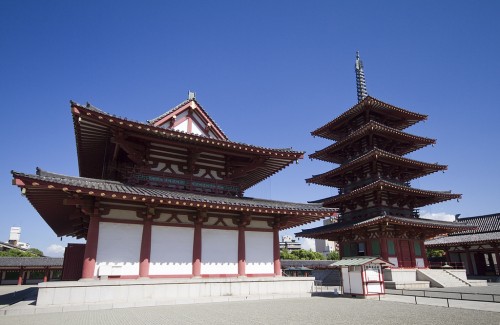
Shitenno-ji Temple, Osaka
In the Middle Ages, Shinran (1173-1262 CE), the founder of Jodo Shinshu (Pure Land), the largest school of Japanese Buddhism today, worshipped Prince Shotoku as the saviour of Japan. Shinran is famous as the first ordained monk to reject his clerical vow of celibacy which set a trend for Japanese clerics. He openly married and had children with Eshinni and the reason for this departure was that Prince Shotoku appeared to him in a dream as the Bodhisattva of Compassion, Kannon, who assured him that he would be incarnated in Eshinni. So, in a way, Shinran married his greatest hero. Shotoku is also said to have reincarnated as Bodhisattva Eshi of the Tendai faith and later as Amida Buddha, the principal Buddha of the Pure Land School.
In conclusion, as Prince Shotoku firmly believed, it is certain that our sincere relationships with each other are the most important factor of all in society and that individual power and success must only be viewed through that lens. But this 17-article constitution could and can only be successful if humans put aside all their self-seeking ideas and temper their dominant egos and temporal desires. This can best be achieved by cultivating Buddha Nature and embodying our divine mission of unconditional love and light. Altruism - sincerely looking after others before ourselves - is an ancient universal tenet of the human species which Prince Shotoku spent his life embodying.
LICENSE
Article based on information obtained from these sources:with permission from the Website Ancient History Encyclopedia
Content is available under License Creative Commons: Attribution-NonCommercial-ShareAlike 3.0 Unported. CC-BY-NC-SA License